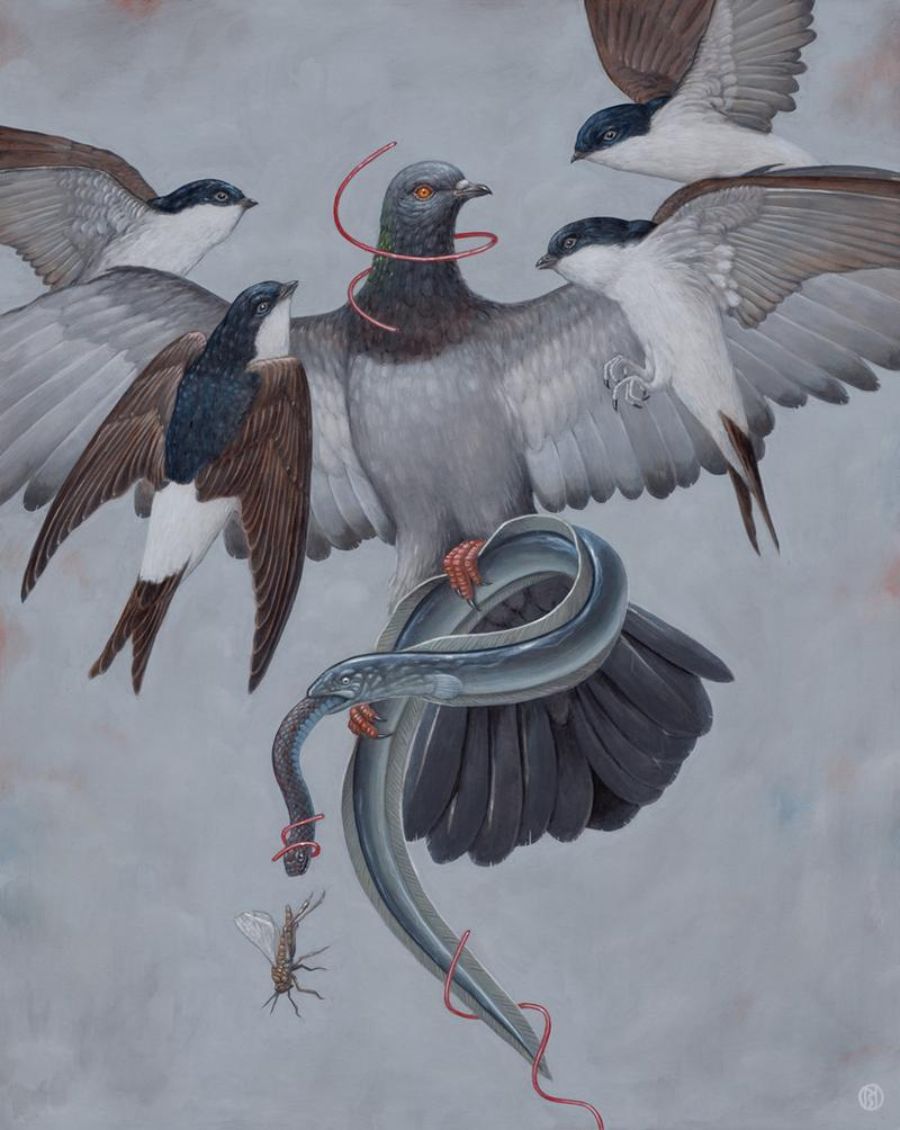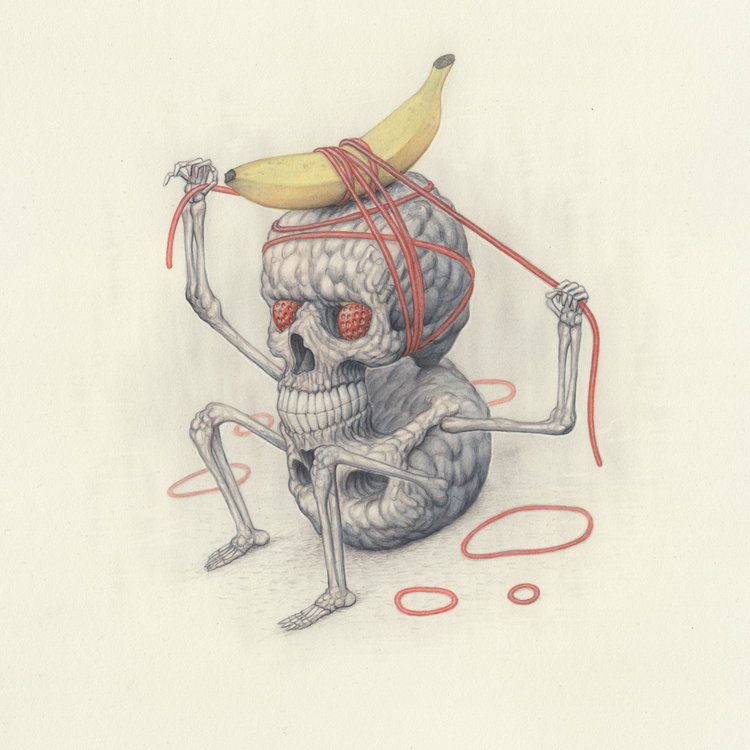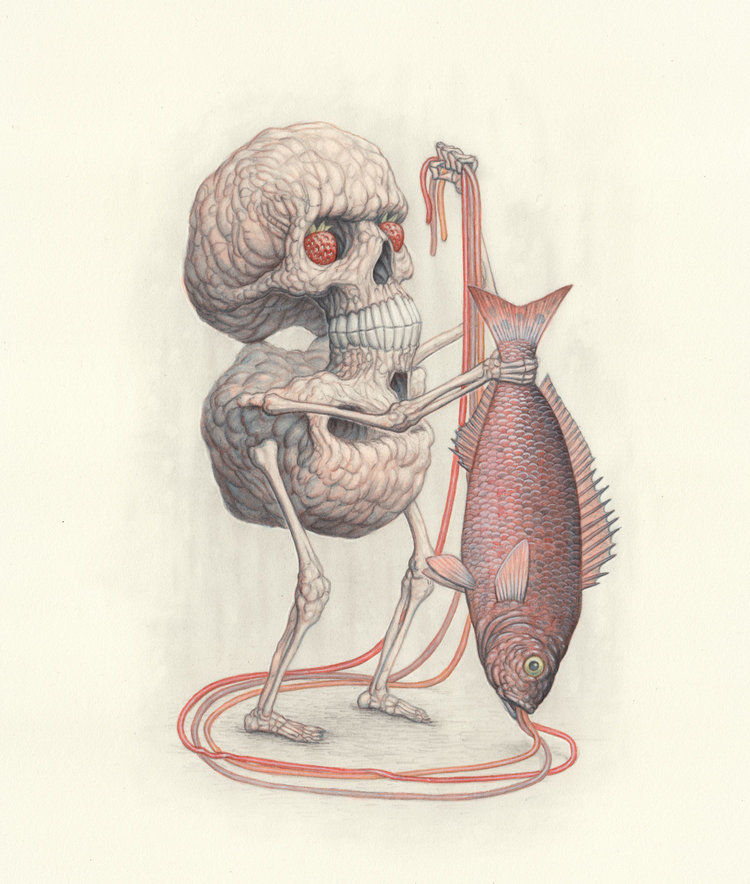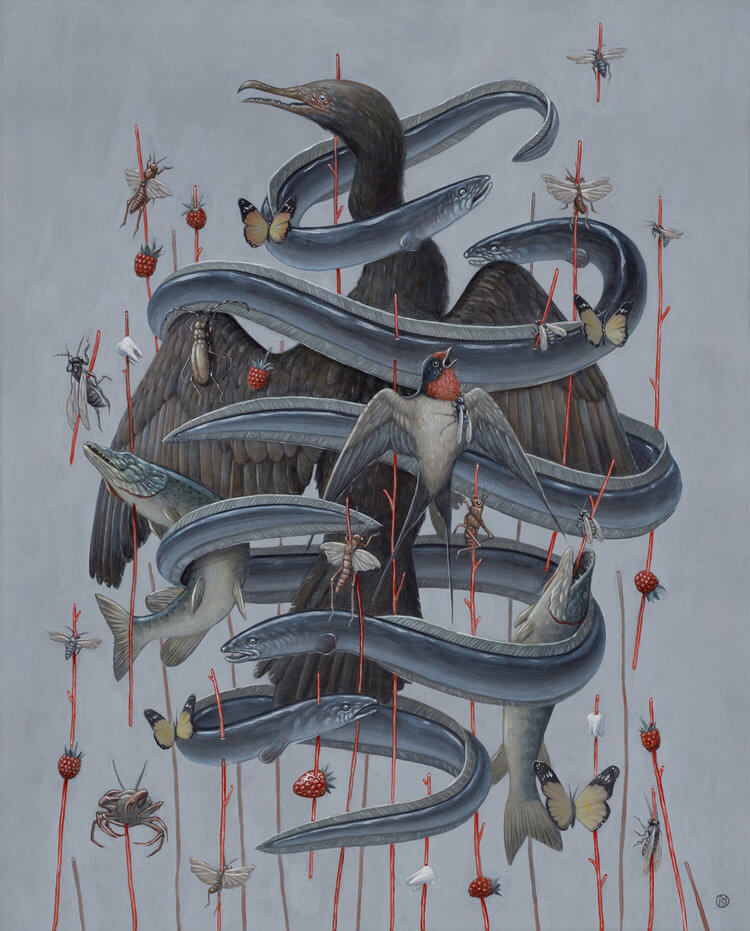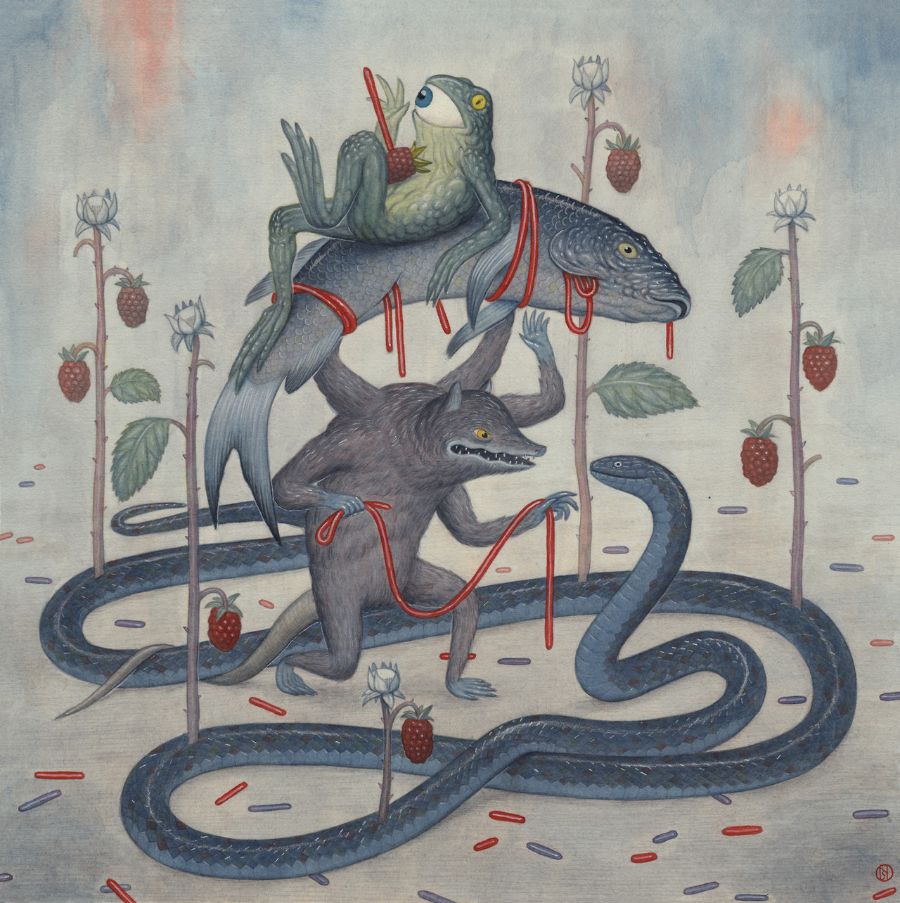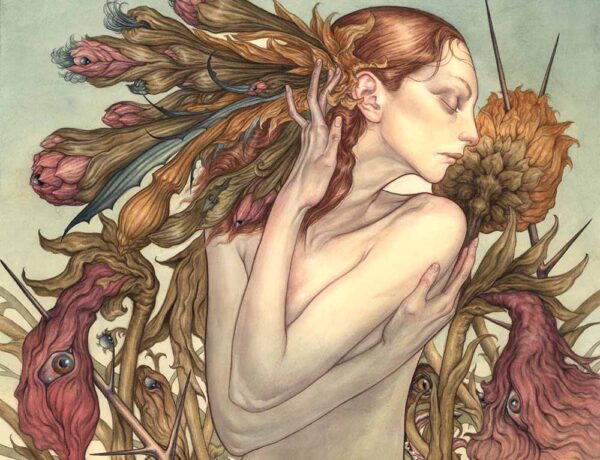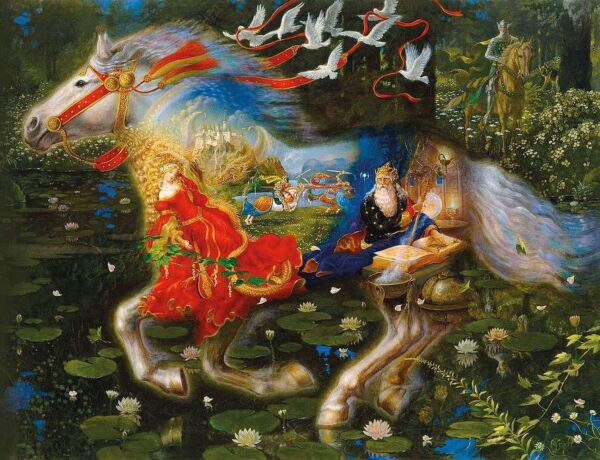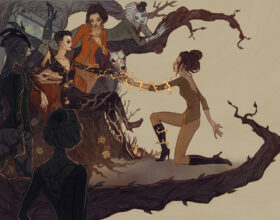You’re tucked in bed after a really long Groundhog Day of pandemic-triggered lockdown. The lights are out. You’re looking forward to finally, maybe, quite possibly getting eight solid hours of zzzzzzzzs. Hey there. Not so fast. It’s your brain talking. I hate to break it to you, but sleep is definitely not happening on my watch. Not tonight. We have far more heady things to occupy ourselves with. Existential angst, for example. Or the myriad ways that we could conceivably meet our maker. You know… the usual. Don’t act surprised. That’s what we get when YOU Insta-binge Nick Sheehy’s art right before bedtime. We talked about this before, remember? Daytime only!
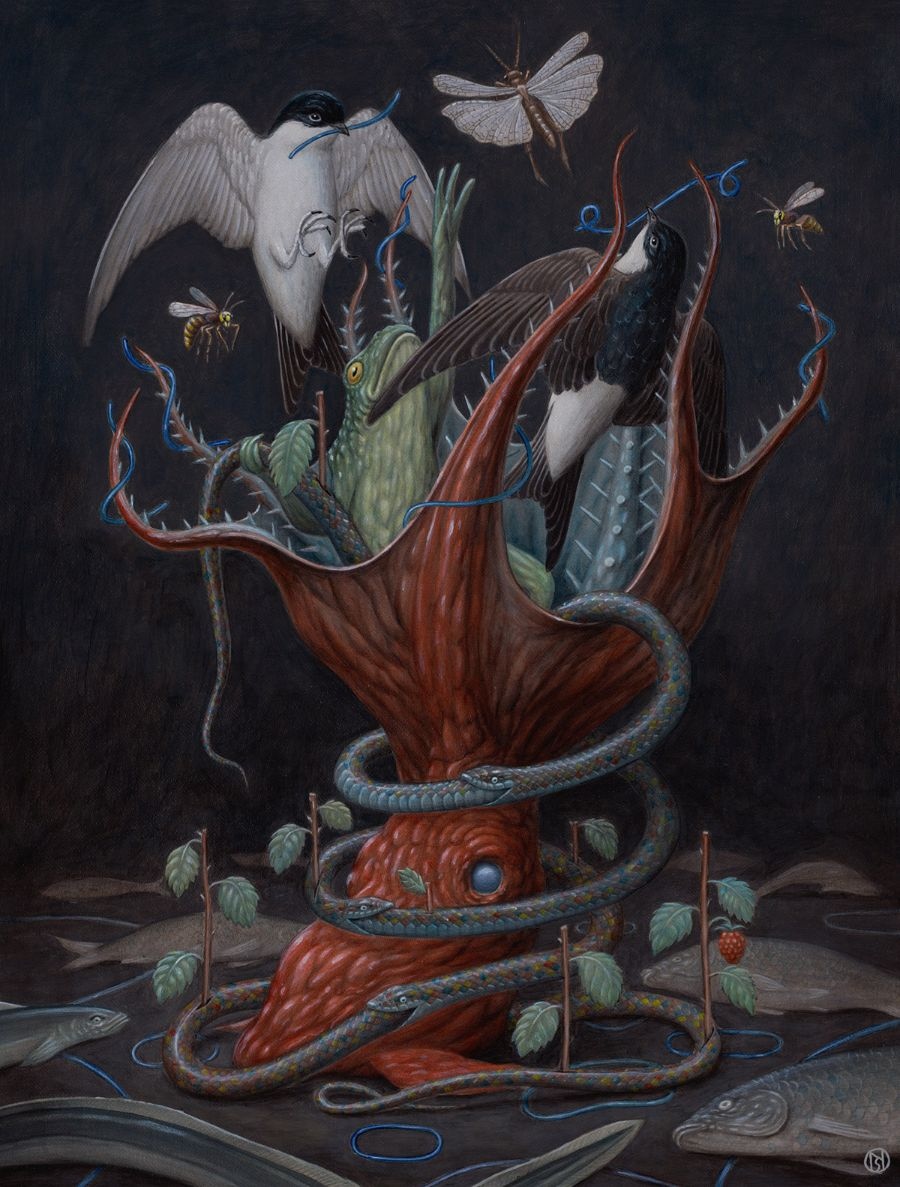
Chatting with your cerebral better half in the wee hours of the morning about such matters isn’t entirely cuckoo. Especially after endlessly scrolling through Nick Sheehy’s art. Welcome to the club. It’s hardly an insult to the Australia-born, London-based painter of ferociously quixotic, nature-laden hell-scapes. His strangely meticulous illustrations aren’t designed to be a quick visual high that is soon forgotten. Sheehy’s oddball wildlife scenes, which almost always involve some sort of rancorous fight for survival or supremacy, have a way of getting under your skin. Take your sweet time exploring Nick Sheehy’s vast portfolio of peculiarities. Even if you’re not a decidedly contemplative individual, you will soon find yourself meditating on life, the universe, and all sorts of menacing ponderings.
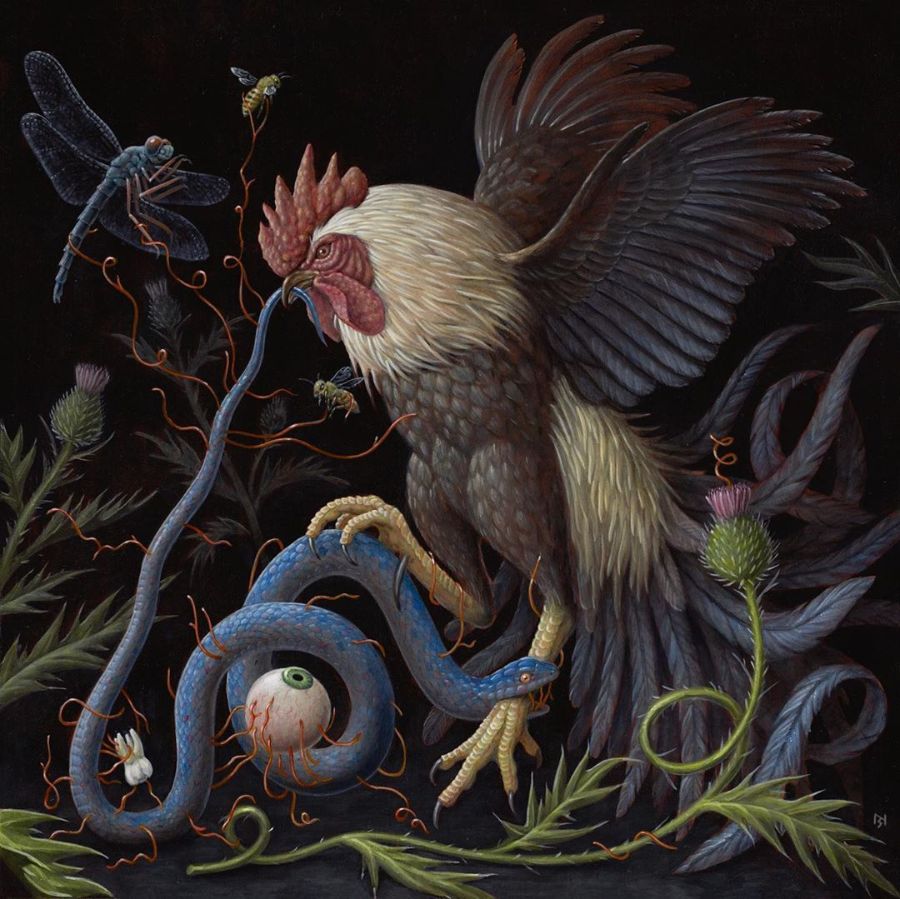
Throughout time, human beings have always demonstrated a flair for being an exceptionally ruthless species. While steeping yourself in Sheehy’s take on the wild kingdom, though, you instantly recognize that Mother Nature could easily hand us our derrieres upon a gilded platter. Quite naturally, that tray would be adorned with our very own severed eyeballs. Just to remind us that she means business, some of our extracted teeth (removed without anesthesia) would grace the perimeter. If unhinged canvas storytelling appeals to you, boy oh boy, you’re definitely going to savor the inner workings of the man behind all of this visual mayhem. I bring you Nick Sheehy, conjurer of critter chaos…
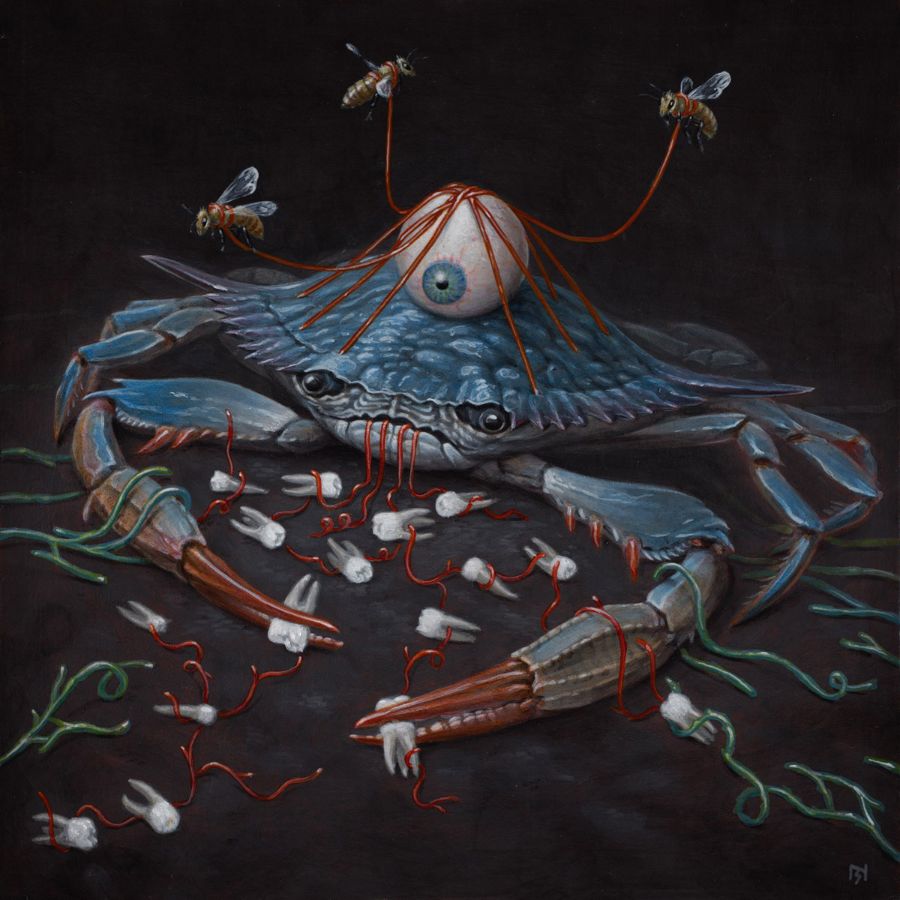
Your art possesses a seemingly contradictory, multi-layered personality. It is partially reserved due to the discreet color palette that you favor. Your artistic execution appears to be controlled and exacting. Perhaps due to the natural science aspect of your work, it generates scholarly vibes. You temper all of those level-headed qualities, however, with a hell-is-breaking-loose reality. Are those your actual artistic intentions or am I way off base??
That’s a nice way of looking at it. Yes, hell is breaking loose. Although sometimes, I think that my images take place after ‘hell has broken loose’, when life is adjusting. Or perhaps just before, just as the panic-buying kicks in. I try not to think about it too much. While I put a lot of effort into painting, I try to keep the thinking to a minimum. Thinking too much gets in the way.
Do you maintain an idea journal in order to create thematic cohesion in your portfolio? Does your art ever emerge out of subconscious, auto-pilot manifestation?
I keep a journal of ideas; either a Moleskine, or quick iPhone/iPad sketches. But they are mainly thumbnail sketches, more concerned with composition, forms, shapes, etc. I take those thumbnails and work on them until I get to a point where I’m happy to paint. I borrow heavily from my previous images, so thematic cohesion is something that comes about naturally. But being on auto-pilot is a useful state of mind. I tend to be less happy with the work I put too much effort into. It’s always nice to surprise yourself a little. I’d love to be completely on auto-pilot and not even need sketches or journals, but I’m not built that way. I need process to make art, and sketches are part of that process.
Anyone who illustrates the type of subject matter that you do surely has nature coursing through their veins. Aside from your wild and wooly Tasmania upbringing, are you a science geek? Maybe just an unabashed tree-hugger? Were you once a wildly successful frog whisperer who then branched out into crocodile dentistry?
I come from a long line of unabashed tree-huggers. I grew up looking at tadpoles running from snakes, climbing trees, sword-fighting with fern fronds, and constantly checking for leeches. I like science, but I wouldn’t say I’m a geek. I know some common names of different species, but I don’t know any Latin names, and I don’t often get too in-depth with my research. Most of the time, I don’t really want my frogs or snakes or whatever to look too much like specific species, otherwise it becomes a distraction.
Just how much of an animal lover are you? Would fishing a kitty fur ball out of your morning coffee make you just shrug your shoulders and smile?
I love animals. I love cats. My biggest artistic challenge is varnishing a painting without cat hairs in it. Animals are just cool. Elephants, insects, frogs, birds, octopuses, etc. So many interesting forms. Just from a sculptural point of view, they’re amazing.

It seems like your left-of-center creativity could be partially attributed to your artsy-earthy upbringing. You describe your parents as being quintessential hippies. Off-the-grid, nature-loving art champions. As the professional artist that you are today, do you look back on that experience with a genuine sense of appreciation?
Haha. I guess so. My parents are definitely left-of-center, off-grid, nature lovers. They saw that I had some artistic ability. They encouraged me. But they left me to make my own choices about what I wanted to pursue.
Your portfolio seems like a visually contemporized love letter to old-school, natural science and botanical illustrations. Did your artistic aesthetic stem from a childhood addiction to naturalist art books? Maybe you devoured your family’s first edition copy of Encyclopaedia Britannica or countless issues of National Geographic Magazine?
Yeah, that’s pretty spot on. I’ve always loved technical illustrations and diagrams. Like most kids, I had a huge love of dinosaur books, etc. I also went through a spell of being into fighter plane books… again, because the diagrams and illustrations looked so cool. One of the most exciting things about getting new LEGO was following the build instructions.
When Beautiful Bizarre Magazine spoke to you last year, you said that conjuring up never-seen-before images is especially important to you. In particular, how did you arrive upon your signature flora and fauna still-life/wildlife arrangements and bouquets?
It’s just a natural pairing in my eyes; balancing out the weird forms of animals doing weird stuff, with weird plants. Like a lot of elements in my work, I probably painted it once, and then repeated it, trying to develop along the way. After a while of building on the visual decision you’ve already made, a language builds up. While flora and fauna is in no way a unique subject to paint for artists, I hope that my work is identifiable.

Your aquatic, reptilian and avian cast of characters frequently engage in underhanded, Fight Club-style battles. Or so it would seem. Is this recurring canvas theme actually inspired – even in some small way — by Chuck Palahniuk’s novel? If not, are you just paying homage to the Darwinian evolutionary theory?
Not really Fight Club — more so Origin of Species. Going back to what you said earlier, I like these weird scenes to be rendered in a matter-of-fact way. I’m not sure if every scene contains aggressive intention, and I try not to worry about good or evil. I like to approach it impartially, or perhaps as a nature documentary. The animals are just doing what they’re doing to survive. Hopefully, the viewer adds their own layer of emotion and invents their own stories.
Let’s imagine that your anthropomorphic, wildlife warriors really are involved in their own Fight Club mayhem. Some of your pieces seem to depict the gnarly crime scene aftermath, presumably perpetrated by one or more impressively dexterous life forms. By any chance, are intellectually evolved mutant frogs with opposable thumbs responsible for the canvas carnage? If not, which species is the ringleader? I did notice a spider-legged opossum freak-of-nature with sophisticated Shibari-esque sewing skills…
I don’t really plan it out that much. I’m not interested in singular ringleaders. A dominant character in one painting might be subservient in another, and phased out in the next. If I get too bogged down in an overarching narrative, then I’d probably get a little bored and want to deviate. Or start panicking when I get to a dead-end, all the while needing another painting for a deadline. I find it’s better to focus on one picture at a time and treat the characters therein with whatever they need.
Despite your depiction of repeatedly diabolical amphibians, you tend to spare them the grisly fate that befalls so many of their wildlife canvas counterparts. Admittedly, in the Sheehy upsidedown, token froggy casualties still do exist. Two fondue-style, berry-skewered victims come to mind. Overall though, they live a somewhat charmed, conveniently bipedal existence. Is that due to your unabashed affection for them?
The frogs may be winning at the moment. But that might not always be the case. You never know what’s around the corner. While they can get around on two legs, grabbing trinkets, finding food, etc., that doesn’t mean they won’t get a beak through their abdomen. I’ve sketched out plenty of scenes where frogs are having a really bad day. Those scenes just haven’t made it into paintings yet.
In your 2015 illustration, titled Inner I, a frog appears to be praying to a higher power. Its guilty conscience is finally kicking in…I hope? Is that frog – and its seemingly alive, snake partner in crime – guilty of vivisectioning all of those fish?!?!
Hahaha. That’s an interesting interpretation. Perhaps. I don’t know. I honestly can’t remember what I was thinking at the time. But the placement of the frog is important. As is the snake. Who knows who is responsible for the state of the fish?
When did bizarre-o themes like these become an integral part of your artistic niche? Were there any particular triggers that led you down this unusual illustrative path?
Darker imagery has always been more fun to draw. I used to like heavy/death metal album artwork. Like Sepultura, Slayer, Metallica, etc. The more gruesome, the better. Eventually, I wanted to tone it down. There are plenty of artists making up weird stuff. I just do it in my own way.
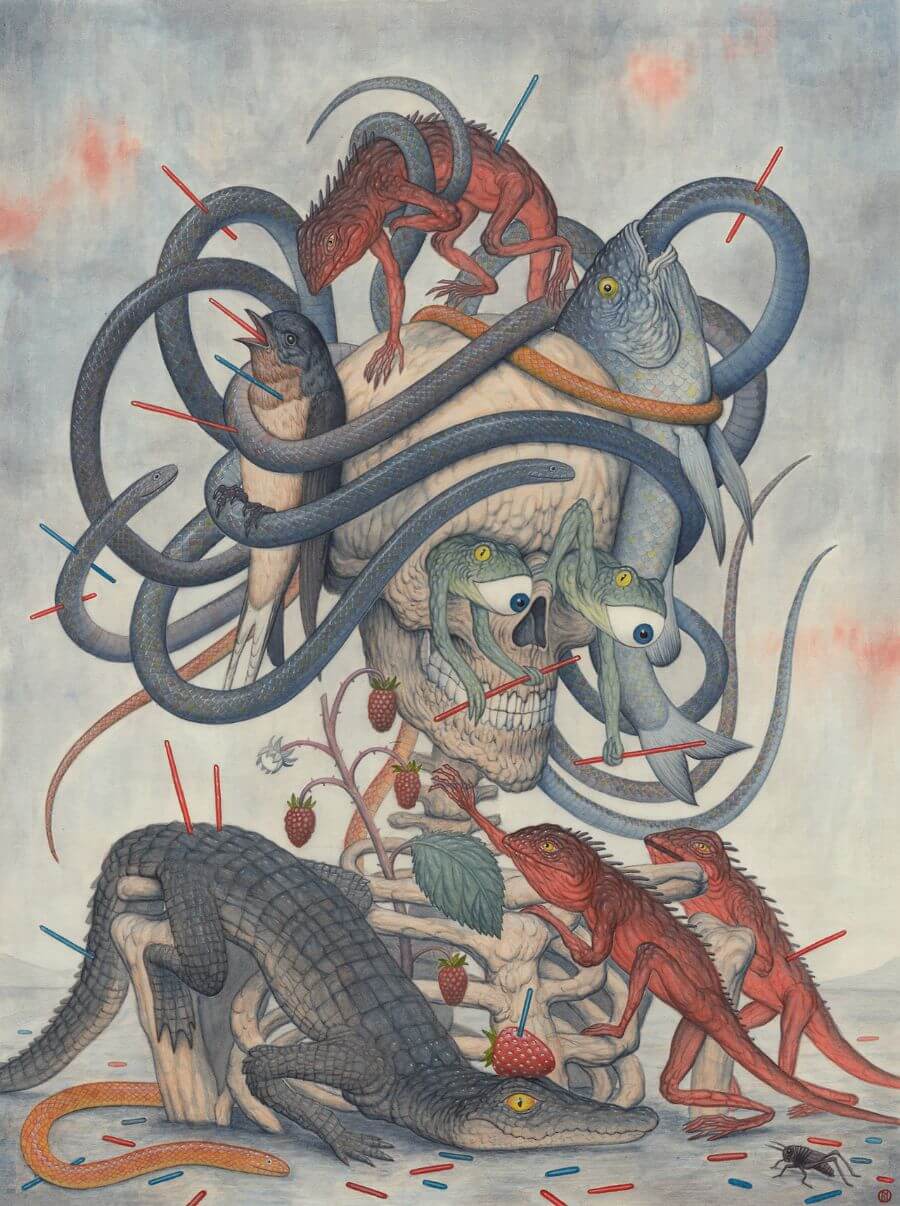
You balance the dark, murderous deadbeats of the wild kingdom with beautiful botanical flourishes. Is there a specific reason why strawberries and raspberries play such a prominent role in your storytelling efforts? Or striped tulips?
The flourishes arrive with specific meanings. But thereafter, the meanings can change from painting to painting, or lose meaning altogether. So if I intended a raspberry to mean “xyz” in one particular painting, it doesn’t necessarily mean that it’s going to be the same in the next painting. Raspberries, strawberries, tulips, thistles, etc. started as references to people and places I love, in particular my wife and family.
Yanked-out teeth and eyeballs also enjoy their fair share of the Nick Sheehy canvas limelight. The loss of those key body parts, according to ‘dream analysis’, alludes to underlying anxieties. Is there a specific metaphysical reason for their disembodied presence in your artwork?
In a world inhabited by animals, they’re a human reference. I also like how they are removable parts of the body, which have important functions for the owner’s survival. Also they’re easily recognisable. And valuable. Maybe useful.
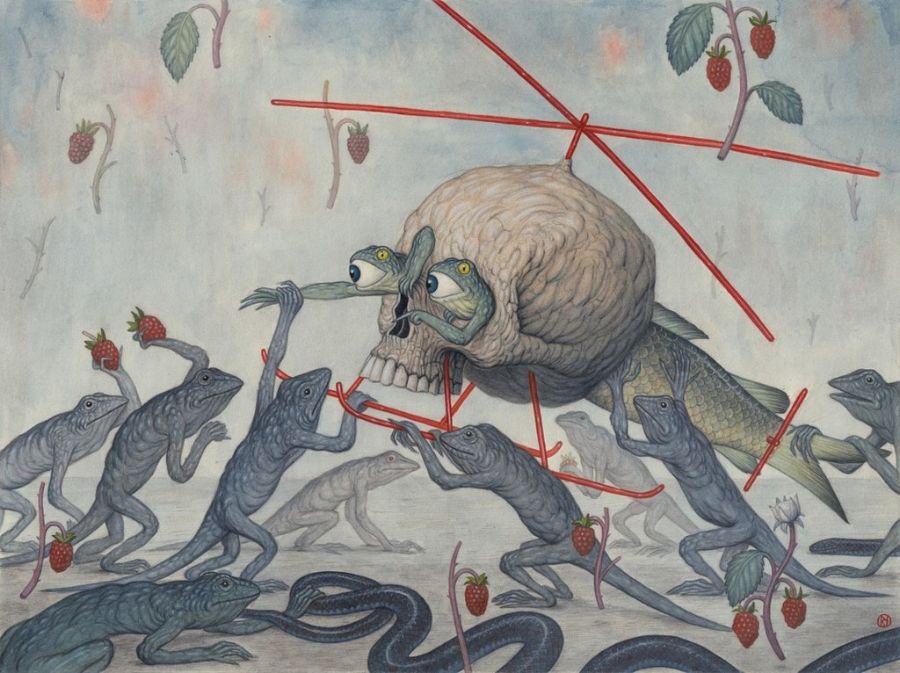
Why do more than a few of your frogs boast a third (human) eye right smack in the middle of their fly holes? Equally as disconcerting are the occasional bird heads peeking out of their mouths.
Maybe they think it can help them see like a human? Or make them wiser? Perhaps it’s just food? Maybe the birds are wearing the frogs, Buffalo Bill style.
At some point in your education, did you ever have to perform frog dissections? Your 2017 watercolor, entitled “The Portrait”, makes me wonder if you liked slicing and dicing them just a little too much?
I had to dissect a rat in high school science class, which wasn’t exactly enjoyable. I think I disengaged and did what needed to be done in order to pass the class. But I do like anatomical illustrations a lot. Many of my pieces have been directly inspired by animal dissection diagrams (which isn’t always a fun thing to research).
Bees and other winged insects are a tried-and-true Sheehy canvas accessory. The global population of moths, butterflies, and bees has been declining for many years. Habitat loss, climate change, exposure to agricultural chemicals and Colony Collapse Disorder are among the top triggers. Have you repeatedly included beneficial pollinators in your paintings to acknowledge their beleaguered status?
Human impact on the planet, habitat loss, the climate crisis, etc. – they’re all a big part of my work. I wouldn’t say I’m deliberately painting any specific creature to acknowledge their survival struggles. I think insects with their expressionless and alien-like faces add an interesting counter to the birds and frogs that are probably easier to identify with.
Given your earth-loving upbringing, have you run with the eco-torch in your own adult life?
I think we all have a responsibility to try and live a life that has minimal impact on the earth. With that in mind, I try not to consume and waste too much. Also, I don’t support brands or corporations that have a negative impact on the planet. I always vote with the environment in mind. I donate to a couple of charities that focus on wildlife and tree preservation. When using my art materials, I do so in a way that minimizes pollution. But I could do more.
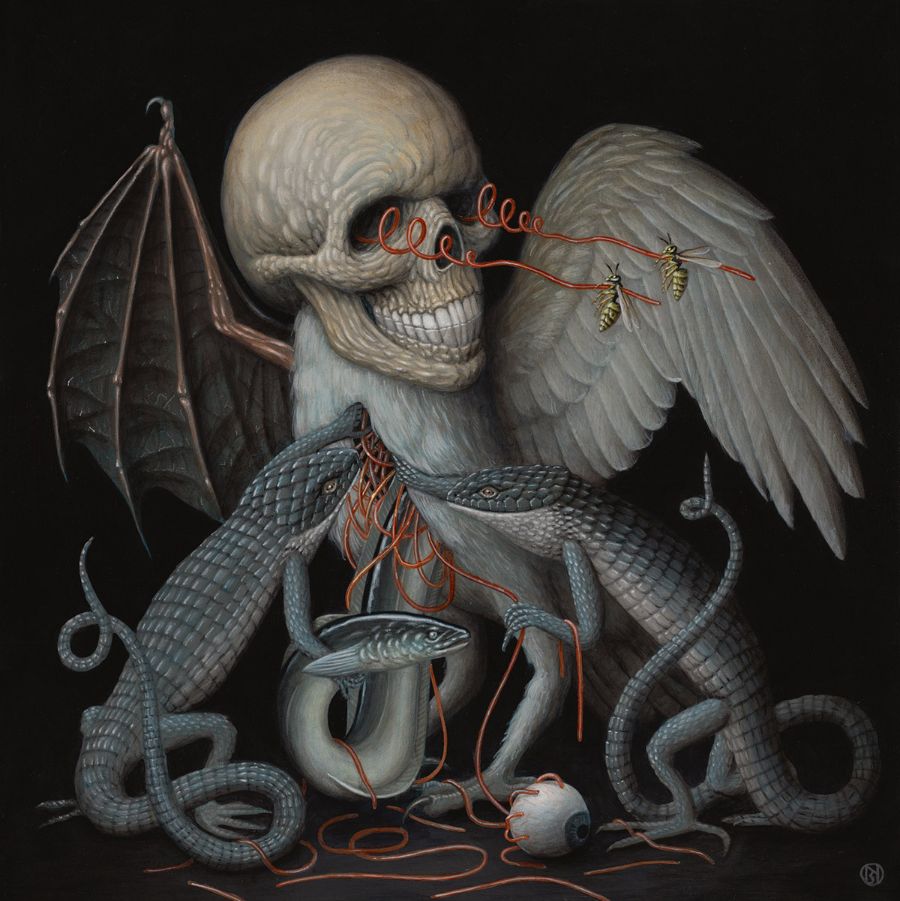
In your canvas universe, winged pollen crusaders typically remain unscathed while crazy critter chaos unravels around them. On occasion, however, the errant bee, yellowjacket or cricket is the victim of a heinous critter-on-critter crime. Impalement via corkscrewed protuberances, twig-like puncture wounds, and even straight pins rammed into abdomens? Come on man, that’s harsh! Do you keep a running list of creatively diverse perils that you may, someday, want to inflict upon your cast of characters?
Hahaha. No. That’s just dark.
The type of canvas storytelling you are known for really seems to click with American and Aussie audiences. Do you attribute that to the open-minded, laid back cultures of both countries?
I don’t think American or Australian audiences are any more open-minded to other places I’ve exhibited. But America does seem to have a wider variety of galleries that support diverse voices, and an art scene that my work can easily slot into.
You’ve mentioned that the British art scene, in contrast, doesn’t seem to favor eclectic art as much. Are UK-based art aficionados inclined to simply just keep calm and carry on?
Over the years, I’ve become disconnected from the UK art scene, so I don’t really know what I’m talking about. I remember being frustrated because galleries only seemed to exhibit ‘high brow’ art, or Street Art, and not much else. Then I had my first solo show in central London, and people turned up! I’ve met and sold work to lots of lovely collectors at exhibitions, or art fairs, etc. So there’s definitely an audience here. The economics of being a permanent smaller gallery and taking risks on lesser-known creators must present challenges. It must be near impossible without a ton of financial backing.
In your previous interview with Beautiful Bizarre Magazine, you told us that you tend to be a harsh critic of your own work. Are you afflicted with canvas dysmorphia?
I think it’s natural for most artists to be harsh on their own work. It’s like a visual catalogue of mistakes you’ve made, that you then force yourself to look at for hours/days/weeks. But I do feel like I could relax a little. You might be onto something with the canvas dysmorphia. The important thing to remember is that you never know what people will be attracted to. I remember a conversation where someone was telling me how much they liked a particular piece of mine. I stupidly and slightly drunkenly responded, “I don’t like that one.” My friend who was running the exhibition gave me a polite telling off after that.
When you look at one of your completed canvases, aren’t you ever genuinely pleased with the outcome? Does that satisfaction fade far too soon? Do your illustrations need to fulfill certain criteria so that your inner critic will back down?
It goes up and down. After finishing something, I’m usually too focused on particular areas where things could be improved. Then after a few days, I start to look at the work with a more even eye. It’s like a good curry. Sometimes it needs time for the flavours to intermingle, so you go back later and see how everything is working together.
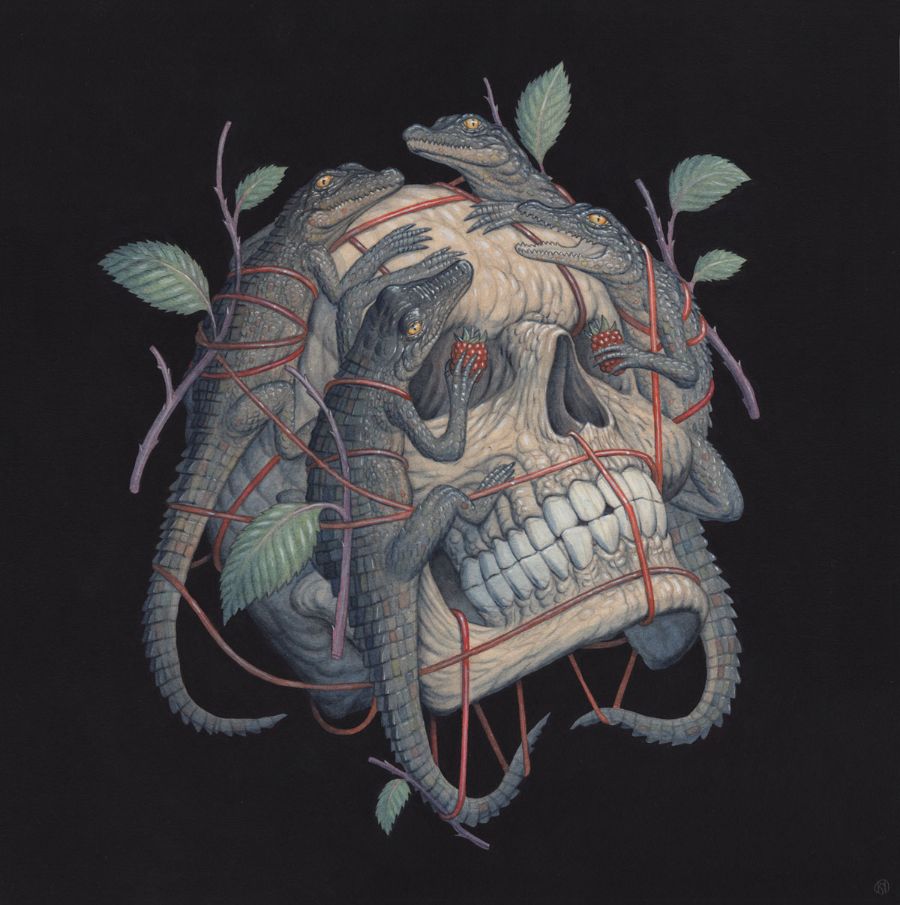
Muted red, blue and green tones, which have become synonymous with the Sheehy aesthetic, have worked quite well for you. Does throwing all caution to the wind by embracing a Harajuku color palette seem the slightest bit tempting, though?
Yes, I’d love to. Perhaps I’m getting there, just very gradually. I do try and shake up my colour choice every now and then. Since my colours get layered — layer upon layer — the overall palette stays fairly muted and consistent without meaning to. Also, I don’t consider colour my greatest strength. I try to stick to a minimal palette to ensure harmony and prevent messing up too much.
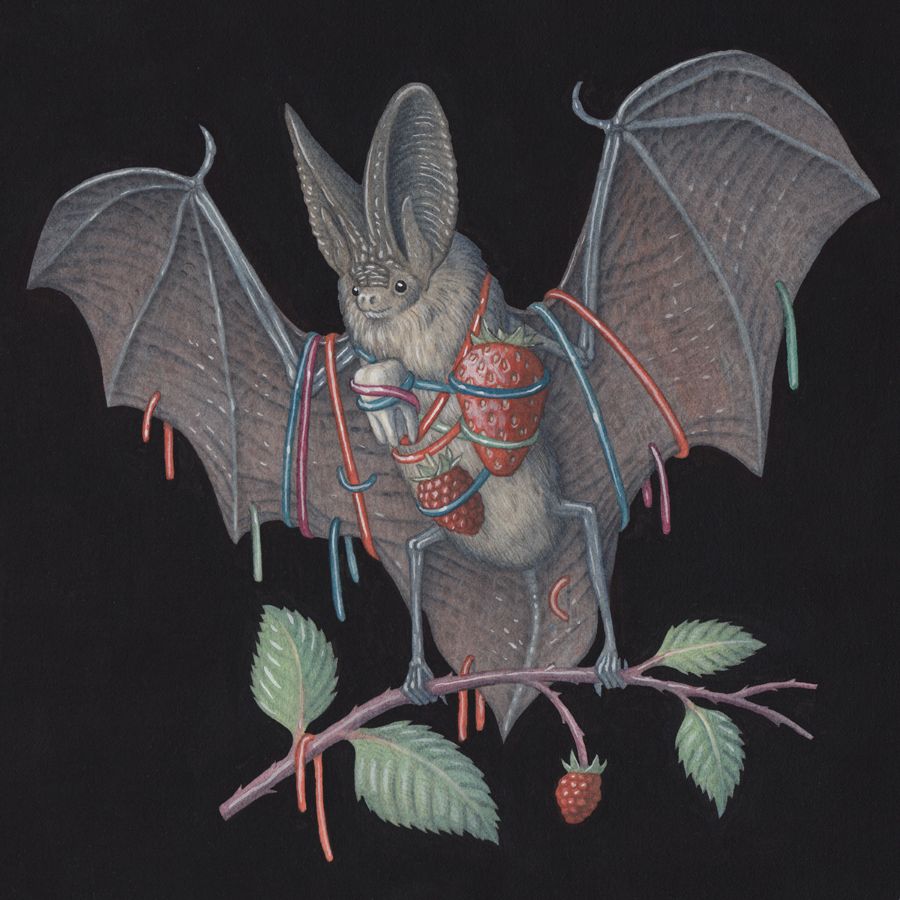
How much artistic risk taking is comfortable for you? Would you ever dare say sayonara to your wild kingdom subject matter, altogether? Maybe you could throw everybody a curve ball by expertly rendering nothing but double-chins.
I’m very process-orientated, so eliminating risk is built-in with every step. I’m trying to relax and allow for mistakes or left turns. I find that doing still life studies as quickly as I can loosens up my painting style. Since learning to paint, I’ve really enjoyed still life. So maybe I’ll go more into that direction, or perhaps I’ll start painting landscapes…with double chins.
These days, are you still cuckoo for acrylics? Is there a life-changing acrylic ‘hack’ that has made your painting ritual far more easy-breezy?
I love acrylics. The best thing about acrylics is their versatility. You can make them thick or thin, bright or dull, opaque or transparent, slow down the drying time or speed it up. But like any medium, you have to make a lot of mistakes before figuring how well it’s going to work for you. I don’t think there’s a single ‘hack’.
The best thing I’ve learned is how to extend the moisture level of acrylics on the pallet for a longer period of time. First I mix my colours with a bit of medium and water. I put the paint in ceramic paint wells and then paint. While they’re open, I mist them with water. I cover them in plastic Ziploc bags when I’m done. The paint will stay wet for weeks if you check it every couple of days. Keeping paints on the go this way is really useful for minimising preparation time. Just get the paints out of the bag, and start painting. Easy breezy!
I read somewhere that part of your artistic education focused on bronze sculpture. Does working in that material require taking out a second mortgage or Insta-pimping your ferret?
I was privileged to focus on bronze sculpture for the last 2 years of my art school experience. It’s labour-intensive, resource-sucking, room-hogging, noisy, messy, heavy, AND expensive. I left art school never wanting to do it again.
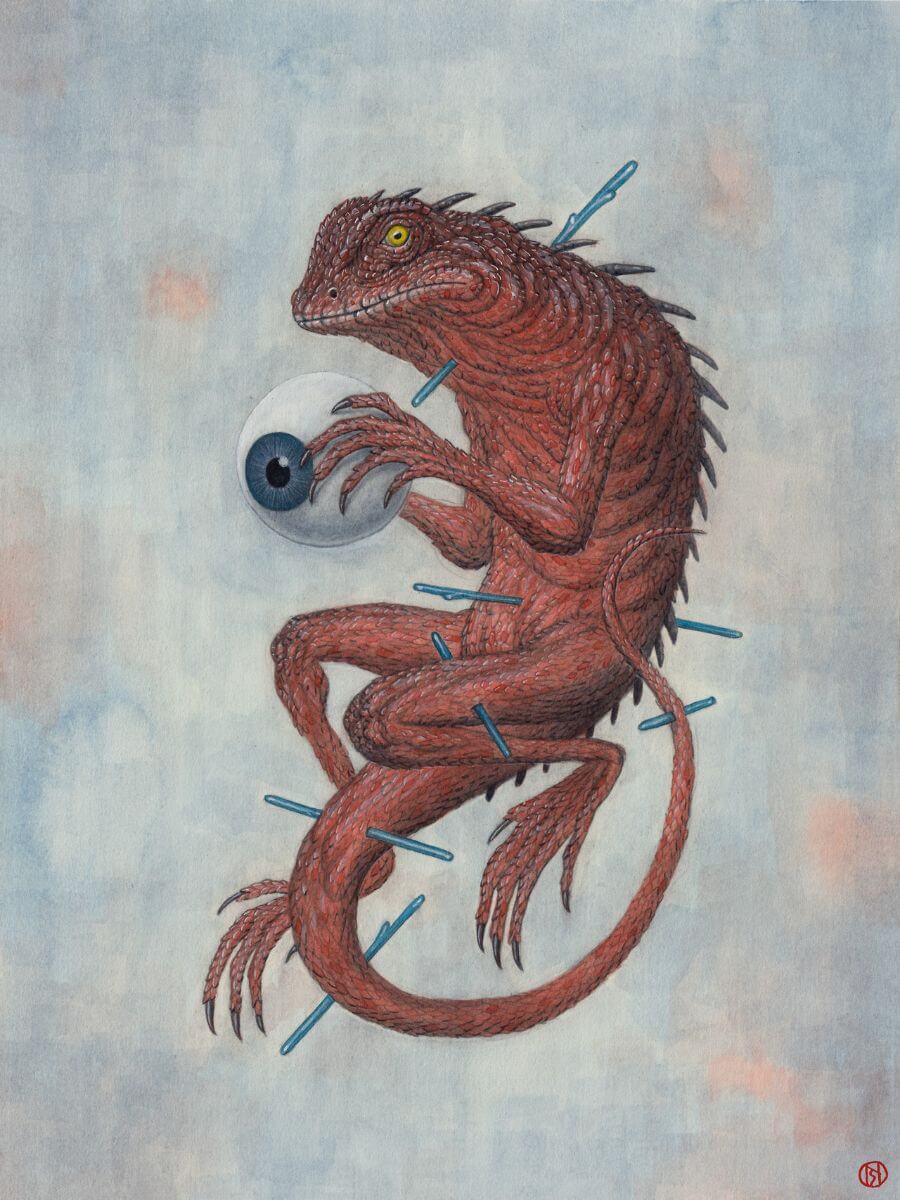
Has that form of three dimensional creative expression finally resurfaced in your life? Is there a cheaper, yet still fulfilling sculptural alternative?
Yes, it’s definitely resurfaced. When I switched from working in graphite and watercolour to acrylic paint, I got closer to a medium that is more sculptural. Graphite and watercolour are very linear mediums. You get darker and darker as you go. You can make things lighter, but it’s not as easy. With acrylic, you can push and pull values much like you’d add and subtract clay. I’ve looked into other 3D materials. But there’s always an exhibition or project deadline looming, so getting the chance to play around is tricky. Also 3D stuff is annoying to store; I don’t have the room.
Did your book about odd, extinct creatures ever come to fruition? Have your illustration skills been tapped for any future publishing projects?
I planned out the book pages, but the project was put on hold while it was being rewritten. We shall see what happens there. I don’t have any other publishing projects in the pipeline.

We are often guilty of judging an artist by their ‘cover’. Sometimes we make presumptions about who they are as a person based on their portfolio aesthetic. With that in mind, please fill in the blank at the end of the following paragraph.
Hey everybody! My name is Nick Sheehy. You may know me from my illustrations that commonly depict the murderous machinations of the wild kingdom. Sure, my art tends to be peculiar, but my fan base seems to appreciate it. Despite what my art may lead you to believe, I do not double-pith spiders in my spare time. Here’s one other fun fact about me that may catch you off-guard:
I’m a goof at heart who can freestyle a pretty decent pasta sauce.
